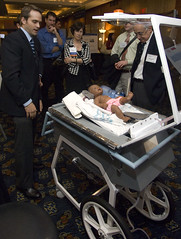 We’ll kick things off with a veritable engine of developing world research that is igniting scientific exploration among developing world scientists: Seedings Labs.
We’ll kick things off with a veritable engine of developing world research that is igniting scientific exploration among developing world scientists: Seedings Labs. The Cambridge social enterprise collects laboratory equipment academic and private sector research labs in the U.S., sorts, refurbishes it when necessary, and ships it to scientists who have passed the Seeding Labs selection criteria. Under the leadership of Echoing Green fellow, Nina Dudnick, the group has grown from a student-run outfit at Harvard to an independent technology transfer powerhouse.
The Cambridge social enterprise collects laboratory equipment academic and private sector research labs in the U.S., sorts, refurbishes it when necessary, and ships it to scientists who have passed the Seeding Labs selection criteria. Under the leadership of Echoing Green fellow, Nina Dudnick, the group has grown from a student-run outfit at Harvard to an independent technology transfer powerhouse.Their mission has multiple benefits in different flavors:
 Greening Science: They are reducing the burden of having to discard surplus laboratory equipment by giving it second tour of duty in labs around the world.
Greening Science: They are reducing the burden of having to discard surplus laboratory equipment by giving it second tour of duty in labs around the world.- Democratizing Research: They are creating a generation of scientists that are home-grown, spurring local and unique research pathways, and opening the science education for students.

- Reversing the Brain Drain: It’s empowering scientists who would otherwise not go back to their countries after receiving advanced training in the West.
 Sustaining Discovery and the Next Great Minds Behind Them: This is not your weekend lab garage sale. By mapping their database of emerging research with a real-time inventory system, they can optimize shipments to the best candidates for cutting edge research in far corners of the earth.
Sustaining Discovery and the Next Great Minds Behind Them: This is not your weekend lab garage sale. By mapping their database of emerging research with a real-time inventory system, they can optimize shipments to the best candidates for cutting edge research in far corners of the earth.
- Back them with your checkbook. All our featured start-ups have real expenses behind their fantastic stories. Send Seedings Labs some Holiday cheer and when one of their scientists makes Nature, you’ll feel like your own private Wellcome Trust.
- Sign up to volunteer: If you want to see the operation first hand, contact Seeding Labs for volunteer opportunities. Packing boxes full of PCR machines and flow cytometers will energize the geek inside you on a Saturday morning
- Spread the Word: Do you work in a lab that has some extra lab equipment looking for a new home? Talk to your boss and show them how Seeding Labs can find a new home in an exotic location. Your corporate social responsibility committee will be the coolest kids in town.

























 This one is better than the superglue for toothaches covered a few months back. The WSJ Health blog describes the case of policeman who had to tase man while he was in the ER (it's better than it sounds).
This one is better than the superglue for toothaches covered a few months back. The WSJ Health blog describes the case of policeman who had to tase man while he was in the ER (it's better than it sounds).


















